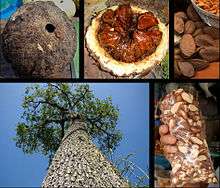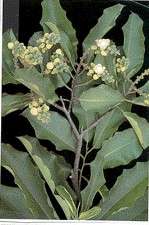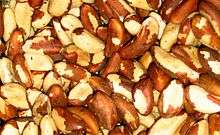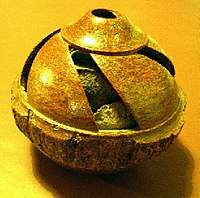Brazil nut
The Brazil nut (Bertholletia excelsa) is a South American tree in the family Lecythidaceae, and is also the name of the tree's commercially harvested edible seeds. It is one of the largest and long-lived trees in the Amazon rainforest. The fruit and its nutshell – containing the edible Brazil nut – are relatively large, possibly weighing as much as 2 kilograms (4.4 lb) in total weight. As food, Brazil nuts are notable for diverse content of micronutrients, especially a high amount of selenium. The wood of the Brazil nut tree is prized for its quality in carpentry, flooring, and heavy construction.[1]
| Brazil nut tree | |
|---|---|
 | |
| Scientific classification | |
| Kingdom: | Plantae |
| Clade: | Tracheophytes |
| Clade: | Angiosperms |
| Clade: | Eudicots |
| Clade: | Asterids |
| Order: | Ericales |
| Family: | Lecythidaceae |
| Subfamily: | Lecythidoideae |
| Genus: | Bertholletia Bonpl. |
| Species: | B. excelsa |
| Binomial name | |
| Bertholletia excelsa Humb. & Bonpl. | |
Etymology and names

In Bolivia and other Spanish-speaking countries, Brazil nuts are called castañas de Brasil, nuez de Brasil or castañas de Pando ("chestnuts from Pando"). In Brazil, they are called castanhas-do-pará (meaning "chestnuts from Pará"), but in Acre they are often called castanhas-do-acre instead.[1] Indigenous names include juvia in the Orinoco area. In Cuba, the nut is alternatively called coquito de Santiago, literally St. James coconut.
In North America, as early as 1896, Brazil nuts were sometimes known by the slang term "nigger toes",[2][3][4] a vulgarity that faded as the racial slur became less used.[5][6]
Taxonomy
The Brazil nut family, Lecythidaceae, is in the order Ericales, as are other well-known plants such as blueberries, cranberries, sapote, gutta-percha, tea, phlox and persimmons. The tree is the only species in the monotypic genus Bertholletia.[1]
Description

The Brazil nut is a large tree, reaching 50 m (160 ft) tall and with a trunk 1 to 2 m (3.3 to 6.6 ft) in diameter, making it among the largest of trees in the Amazon rainforest. It may live for 500 years or more, and can often reach a thousand years of age.[7] The stem is straight and commonly without branches for well over half the tree's height, with a large emergent crown of long branches above the surrounding canopy of other trees.
The bark is grayish and smooth. The leaves are dry-season deciduous, alternate, simple, entire or crenate, oblong, 20–35 cm (7.9–13.8 in) long and 10–15 cm (3.9–5.9 in) broad. The flowers are small, greenish-white, in panicles 5–10 cm (2.0–3.9 in) long; each flower has a two-parted, deciduous calyx, six unequal cream-colored petals, and numerous stamens united into a broad, hood-shaped mass.
Range
The Brazil nut is native to the Guianas, Venezuela, Brazil, eastern Colombia, eastern Peru, and eastern Bolivia. It occurs as scattered trees in large forests on the banks of the Amazon River, Rio Negro, Tapajós, and the Orinoco. The genus is named after the French chemist Claude Louis Berthollet.
As a result, they can be found outside production areas, in the backyards of homes and near roads and streets in the Brazilian North and Northeast. The fruit is heavy and rigid; when the fruits fall, they pose a serious threat to vehicles and people passing under the tree. Brazil nut fruit sinks in water, which can cause clogging of waterways in riparian areas.
Reproduction
Brazil nut trees produce fruit almost exclusively in pristine forests, as disturbed forests lack the large-bodied bees of the genera Bombus, Centris, Epicharis, Eulaema, and Xylocopa which are the only ones capable of pollinating the tree's flowers, with different bee genera being the primary pollinators in different areas, and different times of year.[8][9][10] Brazil nuts have been harvested from plantations, but production is low and is currently not economically viable.[11][12][13]
The fruit takes 14 months to mature after pollination of the flowers. The fruit itself is a large capsule 10–15 cm (3.9–5.9 in) in diameter, resembling a coconut endocarp in size and weighing up to 2 kg (4.4 lb). It has a hard, woody shell 8–12 mm (0.31–0.47 in) thick, which contains eight to 24 wedge-shaped seeds 4–5 cm (1.6–2.0 in) long (the "Brazil nuts") packed like the segments of an orange.
The capsule contains a small hole at one end, which enables large rodents like the agouti to gnaw it open.[14] They then eat some of the seeds inside while burying others for later use; some of these are able to germinate into new Brazil nut trees.[14] Most of the seeds are "planted" by the agoutis in caches during wet season,[14] and the young saplings may have to wait years, in a state of dormancy, for a tree to fall and sunlight to reach it, when it starts growing again. Capuchin monkeys have been reported to open Brazil nuts using a stone as an anvil.
Society and culture
In Brazil, it is illegal to cut down a Brazil nut tree.[15]
Production
| Brazil nut production – 2017 | |
|---|---|
| Country | (tonnes) |
In 2017, global production of Brazil nuts was 84 thousand tonnes, including shells, most of which derive from wild harvests in tropical forests, especially the Amazon. The annual total was consistent since 2009.[17] According to FAO, there were 4 producing countries for brazil nuts in 2017.[16] The largest producer was Brazil, with 39% of the world total, followed by Bolivia, with 30%. The United States was the largest single importer, with 9% of imports.[17]
Environmental effects of harvesting
Since most of the production for international trade is harvested in the wild,[18][19] the business arrangement has been advanced as a model for generating income from a tropical forest without destroying it.[18] The nuts are most often gathered by migrant workers known as castañeros (in Spanish) or castanheiros (in Portuguese).[18] Logging is a significant threat to the sustainability of the Brazil nut harvesting industry.[18][19]
Analysis of tree ages in areas that are harvested shows that moderate and intense gathering takes so many seeds that not enough are left to replace older trees as they die.[19] Sites with light gathering activities had many young trees, while sites with intense gathering practices had nearly none.[20]
European Union import regulation
In 2003, the European Union imposed strict regulations on the import of Brazilian-harvested Brazil nuts in their shells, as the shells are considered to contain unsafe levels of aflatoxins, a potential cause of liver cancer.[21]
Nutrition and human consumption
| Nutritional value per 100 g (3.5 oz) | |
|---|---|
| Energy | 2,743 kJ (656 kcal) |
12.27 g | |
| Starch | 0.25 g |
| Sugars | 2.33 g |
| Dietary fiber | 7.5 g |
66.43 g | |
| Saturated | 15.137 g |
| Monounsaturated | 24.548 g |
| Polyunsaturated | 20.577 g |
14.32 g | |
| Tryptophan | 0.141 g |
| Threonine | 0.362 g |
| Isoleucine | 0.516 g |
| Leucine | 1.155 g |
| Lysine | 0.492 g |
| Methionine | 1.008 g |
| Cystine | 0.367 g |
| Phenylalanine | 0.630 g |
| Tyrosine | 0.420 g |
| Valine | 0.756 g |
| Arginine | 2.148 g |
| Histidine | 0.386 g |
| Alanine | 0.577 g |
| Aspartic acid | 1.346 g |
| Glutamic acid | 3.147 g |
| Glycine | 0.718 g |
| Proline | 0.657 g |
| Serine | 0.683 g |
| Vitamins | Quantity %DV† |
| Thiamine (B1) | 54% 0.617 mg |
| Riboflavin (B2) | 3% 0.035 mg |
| Niacin (B3) | 2% 0.295 mg |
| Vitamin B6 | 8% 0.101 mg |
| Folate (B9) | 6% 22 μg |
| Vitamin C | 1% 0.7 mg |
| Vitamin E | 38% 5.73 mg |
| Minerals | Quantity %DV† |
| Calcium | 16% 160 mg |
| Iron | 19% 2.43 mg |
| Magnesium | 106% 376 mg |
| Manganese | 57% 1.2 mg |
| Phosphorus | 104% 725 mg |
| Potassium | 14% 659 mg |
| Sodium | 0% 3 mg |
| Zinc | 43% 4.06 mg |
| Other constituents | Quantity |
| Water | 3.48 g |
| Selenium | 1917 μg |
| Beta-Sitosterol | 64 mg |
| |
| †Percentages are roughly approximated using US recommendations for adults. Source: USDA Nutrient Database | |

Brazil nuts contain 14% protein, 12% carbohydrate, and 66% fat by weight; 85% of their calories come from fat, and a 100 gram amount provides 656 total calories.[22] The fat components are 23% saturated, 38% monounsaturated, and 32% polyunsaturated.[22][23] Due to their high polyunsaturated fat content, primarily omega-6 fatty acids, shelled Brazil nuts may quickly become rancid.
Nutritionally, Brazil nuts are a rich source (20% or more of the Daily Value, DV) of dietary fiber (30% DV) and various vitamins and dietary minerals. A 100 gram amount (75% of one cup) of Brazil nuts contains rich content of thiamin (54% DV), vitamin E (38% DV), magnesium (106% DV), phosphorus (104% DV), manganese (57% DV) and zinc (43% DV) (right table). Brazil nuts are perhaps the richest dietary source of selenium, with a one-ounce (28 g) serving of 6 nuts supplying 774% DV.[22] This is 10 times the adult U.S. Recommended Dietary Allowance, more even than the Tolerable Upper Intake Level, although the amount of selenium within batches of nuts varies greatly.[24]
The high selenium content is used as a biomarker in studies of selenium intake and deficiency.[25][26] Consumption of just one Brazil nut per day over 8 weeks was sufficient to restore selenium blood levels and increase HDL (good) cholesterol in obese women.[26]
Phytochemicals
The shells of Brazil nuts contain high levels of aflatoxins, which can cause liver damage, including possible cancer, if consumed.[21]
The nuts contain small amounts of radium, a radioactive element, with a concentration of about 1–7 nCi/kg or 40–260 Bq/kg, about 1000 times higher than in several other common foods; according to Oak Ridge Associated Universities, this is not because of elevated levels of radium in the soil, but due to "the very extensive root system of the tree."[27]
Uses
Oil
Brazil nut oil contains 75% unsaturated fatty acids composed mainly of oleic and linoleic acids, as well as the phytosterol, beta-sitosterol,[28] and fat-soluble vitamin E.[29]
The following table presents the composition of fatty acids in Brazil nut essential oil:[22]
| Palmitic acid | 16–20% |
| Palmitoleic acid | 0.5–1.2% |
| Stearic acid | 9–13% |
| Oleic acid | 36–45% |
| Linoleic acid | 33–38% |
| Saturated fats | 25% |
| Unsaturated fats | 75% |
Wood
The lumber from Brazil nut trees (not to be confused with Brazilwood) is of excellent quality, having diverse uses from flooring to heavy construction.[1] Logging the trees is prohibited by law in all three producing countries (Brazil, Bolivia and Peru). Illegal extraction of timber and land clearances present a continuing threat.[30]
Other uses

Brazil nut oil is used as a lubricant in clocks, in the manufacturing of paint, and in the cosmetics industry. Engravings in Brazil nut shells are supposed to have used as decorative jewelry by unnamed indigenous tribes in Bolivia, although no extant examples exist. Because of its hardness, the Brazil nutshell is often pulverized and used as an abrasive to polish materials such as metals and ceramics, in the same way jeweler's rouge is used.
See also
- Brazil nut cake
- List of culinary nuts
- Official list of endangered flora of Brazil
- Brazilwood
- Granular convection
References
- "Bertholletia excelsa (Brazil nut)". CABI. November 19, 2019. Retrieved November 29, 2019.
- A. B. Lyons Plant Names, Scientific and Popular, second edition, page 71
- Young, W. J. (1911). "The Brazil Nut". Botanical Gazette. 52 (3): 226–231. doi:10.1086/330613.
- ""Nigger", noun and adjective". Oxford English Dictionary. 2019. Retrieved November 29, 2019.
- Laurie Essig (July 12, 2016). "White Like Me, Nice Like Me". Psychology Today. Retrieved November 29, 2019.
- Brunvand, J. H. (1972). "The Study of Contemporary Folklore: Jokes". Fabula. 13 (1): 1–19. doi:10.1515/fabl.1972.13.1.1.
- Bruno Taitson (January 18, 2007). "Harvesting nuts, improving lives in Brazil". World Wildlife Fund. Archived from the original on May 23, 2008. Retrieved July 17, 2012.
- Nelson, B. W.; Absy, M. L.; Barbosa, E. M.; Prance, G. T. (1985). "Observations on flower visitors to Bertholletia excelsa H. B. K. and Couratari tenuicarpa A. C. Sm.(Lecythidaceae)". Acta Amazonica. 15 (1): 225–234. doi:10.1590/1809-43921985155234. Retrieved April 8, 2008.
- Moritz, A. (1984). "Estudos biológicos da floração e da frutificação da castanha-do-Brasil (Bertholletia excelsa HBK)". 29. Retrieved April 8, 2008. Cite journal requires
|journal=(help) - Cavalcante, M. C.; Oliveira, F. F.; Maués, M. M.; Freitas, B. M. (October 27, 2017). "Pollination Requirements and the Foraging Behavior of Potential Pollinators of Cultivated Brazil Nut (Bertholletia excelsaBonpl.) Trees in Central Amazon Rainforest". Psyche: A Journal of Entomology. 2012: 1–9. doi:10.1155/2012/978019.
- Scott A. Mori. "The Brazil Nut Industry --- Past, Present, and Future". The New York Botanical Garden. Retrieved July 17, 2012.
- Tim Hennessey (March 2, 2001). "The Brazil Nut (Bertholletia excelsa)". Archived from the original on January 11, 2009. Retrieved July 17, 2012.
- Enrique G. Ortiz. "The Brazil Nut Tree: More than just nuts". Archived from the original on February 16, 2008. Retrieved July 17, 2012.
- Haugaasen, Joanne M. Tuck; Haugaasen, Torbjørn; Peres, Carlos A.; Gribel, Rogerio; Wegge, Per (March 30, 2010). "Seed dispersal of the Brazil nut tree (Bertholletia excelsa) by scatter-hoarding rodents in a central Amazonian forest". Journal of Tropical Ecology. 26 (3): 251–262. doi:10.1017/s0266467410000027. ISSN 0266-4674.
- Center for International Forestry Research
- "Brazil nut production in 2017; Crops/Regions/World list/Production Quantity (pick lists)". UN Food and Agriculture Organization, Corporate Statistical Database (FAOSTAT). 2018. Retrieved December 9, 2019.
- Kosikova, Daria (July 21, 2016). "Brazil Nut Market - Globalization on the Brazil Nut Market". IndexBox. Retrieved June 16, 2017.
- Kate Evans (November 7, 2013). "Harvesting both timber and Brazil nuts in Peru's Amazon forests: Can they coexist?". Forests News. Retrieved May 2, 2019.
- Mark Kivner (May 11, 2010). "Intensive harvests 'threaten Brazil nut tree future'". BBC News: Science and Environment. Retrieved May 2, 2019.
- Silvertown, J. (2004). "Sustainability in a nutshell". Trends in Ecology & Evolution. 19 (6): 276–278. doi:10.1016/j.tree.2004.03.022. PMID 16701269.
- "Commission Decision of July 4, 2003 imposing special conditions on the import of Brazil nuts in shell originating in or consigned from Brazil". Official Journal of the European Union. July 5, 2012. Retrieved July 17, 2012.
- "Nutrition facts for Brazil nuts, dried, unblanched, 100 g serving". Self NutritionData. Conde Nast; US Department of Agriculture National Nutrient Database, version SR-21. 2014. Retrieved December 30, 2014.
- "Nuts, Brazil nuts, dried, unblanched per 100 grams". National Nutrient Database, United States Department of Agriculture. Retrieved July 24, 2017.
- Chang, Jacqueline C.; Walter H. Gutenmann; Charlotte M. Reid; Donald J. Lisk (1995). "Selenium content of Brazil nuts from two geographic locations in Brazil". Chemosphere. 30 (4): 801–802. Bibcode:1995Chmsp..30..801C. doi:10.1016/0045-6535(94)00409-N. PMID 7889353. 0045-6535.
- Garcia-Aloy, Mar; Hulshof, Paul J. M.; Estruel-Amades, Sheila; Osté, Maryse C. J.; Lankinen, Maria; Geleijnse, Johanna M.; de Goede, Janette; Ulaszewska, Marynka; Mattivi, Fulvio; Bakker, Stephan J. L.; Schwab, Ursula; Andres-Lacueva, Cristina (March 19, 2019). "Biomarkers of food intake for nuts and vegetable oils: an extensive literature search". Genes and Nutrition. 14 (1): 7. doi:10.1186/s12263-019-0628-8. ISSN 1555-8932. PMC 6423890. PMID 30923582.
- Souza, R. G. M.; Gomes, A. C.; Naves, M. M. V.; Mota, J. F. (April 16, 2015). "Nuts and legume seeds for cardiovascular risk reduction: scientific evidence and mechanisms of action". Nutrition Reviews. 73 (6): 335–347. doi:10.1093/nutrit/nuu008. ISSN 0029-6643. PMID 26011909.
- "Brazil Nuts". Oak Ridge Associated Universities. January 20, 2009. Retrieved December 17, 2018.
- M. Kornsteiner-Krenn; KH Wagner; I. Elmadfa (2013). "Phytosterol content and fatty acid pattern of ten different nut types". International Journal for Vitamin and Nutrition Research. 83 (5): 263–70. doi:10.1024/0300-9831/a000168. PMID 25305221.
- E. Ryan; K. Galvin; TP O'Connor; AR Maguire; NM O'Brien (2006). "Fatty acid profile, tocopherol, squalene and phytosterol content of brazil, pecan, pine, pistachio and cashew nuts". International Journal of Food Sciences and Nutrition. 57 (3–4): 219–28. doi:10.1080/09637480600768077. PMID 17127473.
- "Greenpeace Activists Trapped by Loggers in Amazon". Greenpeace. October 18, 2007. Retrieved July 17, 2012.
| Wikimedia Commons has media related to Bertholletia excelsa. |
| Wikispecies has information related to Bertholletia excelsa |
| Wikisource has the text of the 1911 Encyclopædia Britannica article Brazil Nuts. |
